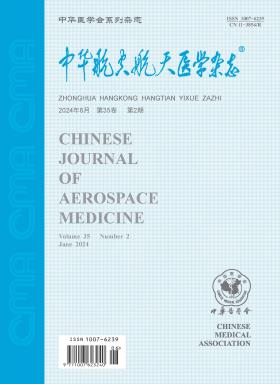磁共振成像在民航飞行员隐匿性心肌疾病诊断中的应用
引用次数: 0
摘要
目的探讨心脏磁共振成像(CMR)在民航飞行员体格检查中评估隐匿性心肌疾病的实用价值。方法对2012-2016年因心电图或超声心动图异常诊断为可疑心肌疾病的飞行员进行CMR检查。采用3.0 Tesla MRI扫描仪(Magnetum, Tim Trio, Siemens)进行CMR。扫描方案为心功能标准,第一次灌注(Magvist, 0.15 mmol/kg),晚期钆增强。CMR图像分析和诊断由经验丰富的医生完成。结果6名飞行员接受CMR考试,其中男性6名,年龄24 ~ 52岁。所有图像质量足以用于分析和诊断。最终诊断为肥厚性心肌病3例,高血压性左室肥厚1例,左室不压实(LVNC) 1例,排除心肌疾病可能性1例。在随访中,所有患者均未报告临床心血管事件。只有LVNC的病例恶化为扩张型心肌病,收缩功能降低。结论飞行员可发生隐匿性心肌疾病。CMR对飞行员人群可疑心肌疾病的诊断和评价具有重要价值。关键词:心脏;磁共振成像;心肌病;心电描记法;飞行员本文章由计算机程序翻译,如有差异,请以英文原文为准。
Application of magnetic resonance imaging in the evaluation of occult myocardial diseases in civil aviation pilots
Objective
To investigate the practical value of cardiac magnetic resonance imaging (CMR) in evaluating the occult myocardial disease in the physical examination for civil aviation pilots.
Methods
The pilots who diagnosed as suspicious myocardial disease due to the abnormal electrocardiography or echocardiography from 2012-2016 were referred to CMR examination. CMR were performed by a 3.0 Tesla MRI scanner (Magnetum, Tim Trio, Siemens). Scanning protocol consisted with standard cardiac function, first perfusion (Magvist, 0.15 mmol/kg), and late gadolinium enhancement. CMR image analysis and diagnosis were done by experienced doctors.
Results
Six pilots received CMR exams (6 males, age range by 24-52 years). All images quality was good enough for analysis and diagnosis. Finally, 3 cases were diagnosed as hypertrophic cardiomyopathy, 1 case was hypertensive left ventricular hypertrophy, 1 case was left ventricular non-compaction (LVNC) and 1 case was eliminated the possibility of myocardial disease. In follow-up, no clinical cardiovascular events were reported in all patients. Only the case with LVNC deteriorated into dilated cardiomyopathy with reduced systolic function.
Conclusions
Occult myocardial diseases could occur in pilots. CMR is very valuable in diagnosing and evaluating suspicious myocardial diseases for pilot population.
Key words:
Heart; Magnetic resonance imaging; Cardiomyopathies; Electrocardiography; Pilots
求助全文
通过发布文献求助,成功后即可免费获取论文全文。
去求助
来源期刊

中华航空航天医学杂志
航空航天医学
自引率
0.00%
发文量
2962
期刊介绍:
The aim of Chinese Journal of Aerospace Medicine is to combine theory and practice, improve and popularize, actively advocate a hundred flowers bloom and a hundred schools of thought contend, advocate seeking truth from facts, promote the development of the related disciplines of aerospace medicine and human efficiency, and promote the exchange and penetration of aerospace medicine and human efficiency with other biomedical and engineering specialties.
Topics of interest for Chinese Journal of Aerospace Medicine include:
-The content of the journal belongs to the discipline of special medicine and military medicine, with the characteristics of multidisciplinary synthesis and cross-penetration, and mainly reflected in the aerospace industry, aerospace flight safety and efficiency, as well as the synthesis of special medicine, preventive medicine, environmental medicine, psychology, etc.
-Military aeromedicine (Air Force, Navy and Army aeromedicine) and civil aeromedicine, with a balance of aerospace medicine are the strengths of the journal.
-The change in aerospace medicine from a focus on promoting physiological compensatory adaptations to enhancing human performance under extreme environmental conditions is what the journal is helping to promote.
-The expansion of manuscripts in high altitude medicine is also a special emphasis of the journal.
 求助内容:
求助内容: 应助结果提醒方式:
应助结果提醒方式:


